This article was updated on May 1st, 2023

When a previously house-trained older dog is peeing in the house, and it’s not just a one-off ‘accident’, it’s easy to become frustrated, and normal to worry. You are not the first owner to wonder what is going on, and what you can do to stop it. Our veterinary team surveyed 258 owners of senior dogs who suddenly started peeing inside the house. We found that these peeing issues were due to a medical condition – in almost 90% of cases. The first thing you should do when your old dog is starting to pee inside is to work with your vet to identify any potential medical problems.
In this article, we will review the most frequent reasons causing senior dogs to suddenly start peeing inside, as well as 6 easy ways to manage your senior friend’s incontinence.
Why Is Your Dog Peeing Inside? Answer These Questions to Find Out
Before we review the most frequent reasons causing senior dogs to pee inside, you can also answer these 2 questions below to get personalized information from our veterinarians:
Most Frequent Reasons Causing Senior Dogs To Suddenly Start Peeing Inside
Serious medical issues such as kidney disease, diabetes, or dementia (Old dog syndrome) often affect older dogs (age 7-8 and older). Peeing indoors happens to be one of the symptoms often observed with these conditions. Other medical conditions causing indoor peeing – such as urinary tract infections – are relatively benign when treated quickly.
It is important that you understand the root cause of your old dog peeing indoors to ensure that your dog gets the right treatment. Let’s look at the most frequent reasons causing a previously house-trained senior dog to start peeing inside:
1. Urinary Tract Infection
Symptoms:
- Frequent & urgent need to pee: your dog needs to ‘go’ a lot more often than normal… and the urge to pee seems to be… well… suddenly extremely urgent!
- Your dog may only pass a few drops of urine even though they’ve been dancing around in circles as if their bladder was bursting.
- Cloudy urine
- Traces of blood in urine
- Frequent licking at genitals
Any dog can get a urinary tract infection, although it’s most often seen in females. Urinary tract infections are usually cured pretty easily, but you NEED to get the right antibiotic prescription from your vet. Although UTIs are obviously uncomfortable (even painful) for your dog and inconvenient for everyone, they are generally not serious, to begin with.
However, repeated UTI’s can also be caused by diabetes, kidney problems, and bladder/kidney stones. If you leave the problem untreated, it can become serious and affect other organs, such as the kidneys.
2. Kidney Infections / Disease
Dogs with kidney infections may show only signs of urinary tract infection, but more often, there are other symptoms as well, including:
- Excessive thirst
- Increased urination / peeing a lot
- Vomiting
- Diarrhea or
- Lethargy
These symptoms can be caused by kidney ‘insufficiency’, kidney stones, or kidney failure.
Many senior dogs have ‘kidney disease’ (this means that their kidneys aren’t filtering out toxins efficiently). Two of the most common symptoms of failing kidneys are excessive thirst and increased urination. But you’re likely to see both as a result of several other conditions, so don’t jump to the conclusion of kidney disease just based on this.
Kidney disease can be treated with many different medications, which your vet will choose based on your individual dog. Your dog may also need intravenous fluid therapy to flush out excess urea in the blood. Your veterinarian is the best person to determine the most appropriate treatment.
3. Diabetes
Diabetes can occur at any age, but it is more likely to happen to senior dogs (Most dogs who develop this condition are 5 or older at the time of diagnosis).
Symptoms:
- Excessive thirst
- Increased urination
- Increased appetite
- Weight loss
- Lethargy
- Repeated UTI’s
Two very common symptoms of diabetes in older dogs are increased thirst and increased urination. So, if your older dog is peeing in the house and seems to be extra-thirsty, diabetes could potentially be the reason why your old dog suddenly started peeing in the house.
This is a condition that you need to get under control otherwise, it can cause serious health problems for your dog. If you notice these symptoms, get your old dog to your vet asap. Diabetes needs to be treated with insulin, which will probably require injections twice a day, as well as a diet change. Learn more on our page about diabetes in older dogs.
4. Cushing’s Disease
Symptoms:
- Excessive thirst
- Frequent urination
- Increased appetite
- Lethargy
- Thinning coat/hair
- Swollen belly
- Loss of muscle tone/strength
Cushing’s disease happens when your dog’s adrenal glands produce more cortisol than is needed, and their body is flooded with the natural steroid. This can produce all kinds of different symptoms, including increased urination. There are two types of Cushing’s disease: pituitary-dependent and adrenal-dependent. Pituitary-dependent Cushing’s disease can be treated medically with either trilostane or mitotane, whereas adrenal-dependent Cushing’s disease is often treated with surgery.
5. Canine Cognitive Dysfunction
Symptoms:
- Incontinence
- Sleep disruptions
- Loss of appetite
- Confusion
- Behavior changes
- Restlessness
- Shaking, trembling, panting
An older dog peeing in the house frequently, especially a ‘senior’ dog (and large or extra-large breeds can be considered seniors as early as seven years old), might be suffering from Canine Cognitive Dysfunction.
It’s also known as ‘Old Dog Syndrome’ and is very similar to human Alzheimer’s Disease or dementia. In this case, the physical cause for the unusual peeing isn’t located in the bladder/kidneys, but in Fido’s brain.
The changes that are going on there make them confused, and they might be urinating indoors because they’ve ‘forgotten’ that they’re supposed to do their business in the yard. Sometimes old dogs with this condition seem to be unaware of their surroundings, or actions, and they might not even realize they’re peeing (or pooping) at the time, or afterward.
There are lots of different symptoms of Canine Cognitive Dysfunction, and urinary incontinence is just one of them.
Although this all sounds worrying, there are things you and your veterinarian can do to help your senior dog if he does turn out to be experiencing old dog syndrome.
Sometimes these symptoms can come on very slowly, and owners think it’s just that their pooch is getting old. But normal aging doesn’t make a dog upset, anxious, miserable, or confused! Your vet can make a diagnosis and make sure Fido gets the right treatment. There are medical options available to improve the functioning of the brain.
6. Bladder Issues
Bladder issues such as cystitis and irritation within the bladder can lead to a constant sensation of needing to urinate. One major cause of bladder irritation is the formation of crystals within the urine which, if left untreated, can develop into bladder stones. Concentrated urine, infection, and other chemical imbalances can lead to the formation of these crystals. These crystals can act like sand within the bladder, causing abrasion to the sensitive bladder lining, thus leading to bleeding and discomfort. In severe cases, bladder stones can block the urethra, thus preventing urine from being able to pass, this is an emergency, potentially life-threatening condition.
Another bladder issue that is of more relevance in older dogs is bladder neoplasia, or bladder cancer. Tumors developing in the bladder wall will result in extreme irritation and will reduce the bladder’s ability to retain urine, thus creating the sensation of needing to urinate more frequently.
Symptoms:
- Frequent urination
- Blood in urine
- Pain/excessive straining when urinating
- Visible ‘sand’ in the urine
- Lethargy
Diagnosis is achieved via analyzing the urine under a microscope for signs of crystals or abnormal cells, bladder x-rays, and ultrasound scans of the bladder.
Treatment options:
The treatment of crystals within the urine will depend on the type of crystals present. Some crystals will dissolve once the urine becomes more dilute or if the pH is changed, whereas other crystals are insoluble once they have formed. For the former, changes in diet, rehydration, and treatment of any concurrent infection can allow the crystals to dissolve. For the latter, the crystals or stones sometimes must be removed via surgery through a procedure known as a cystotomy. This involves surgically opening the dog’s bladder in order to manually remove the stones.
Treatment of bladder cancer is via surgical removal (although this can be challenging) or chemotherapy. This will depend on the type of cancer present and how invasive it is.
7. Hormone Related Incontinence
Muscles around the bladder/sphincter lose elasticity with age, and that means Fido is no longer able to control the flow of urine properly. Your dog may simply not be able to hold it until they are outside, and may need to pee more frequently.
How do you know if your dog’s incontinence is due to hormones? If it is, you will likely observe the following symptoms:
- They are typically a spayed, older female
- Urine leaks, dribbles, or floods (your dog is not intentionally squatting to get in position to pee)
- Urine leaks when your dog is resting (your dog’s bed might get wet spots)
A drop in hormones can cause urinary incontinence and/or thyroid dysfunction: dropping hormone levels are most often seen in senior spayed female dogs, but they can happen to male dogs too. Estrogen is needed to maintain the tone of the sphincter muscle, which keeps the urine in the bladder. There are several different treatment options for this problem, and your veterinarian can diagnose and treat it.
If you find yourself (and your dog) in this situation, there are things you can do to make life easier, and more comfortable, for everyone. It is just a case of making changes in your senior dog’s day-to-day life. Learn more about this on our page about managing old dog incontinence.
8. Emotional Reasons
There can be emotional triggers for your older dog’s sudden incontinence. Your old dog may be peeing inside the house due to territorial behavior, anxiety, or stress.
Some older dogs become especially fragile emotionally as they age, and loud noises, strange people, car rides, storms…. even things they were previously fine with are suddenly scary for them. This kind of anxiety can lead to all sorts of nervous behaviors, including urinating indoors at odd times. If you believe your old friend started peeing inside for emotional or anxiety reasons, read our article: What to do if your old dog starts peeing inside because of emotional reasons.
6 Ways To Help Manage Dog Incontinence – and Avoid Messes!
While you wait for your visit to the vet and experiment with treatment options to solve your dog’s incontinence, you can also do a few things to make life with a leaky dog easier for everyone. Sometimes, incontinence in dogs can’t be helped by medications/treatment and simply needs to be managed. In that situation, the focus is on products to make living with an incontinent dog easier.
1. Try Doggie Diapers: Doggie diapers will help protect your carpets, bedding, and furniture from constantly being dripped on or flooded when your old dog is peeing in the house.
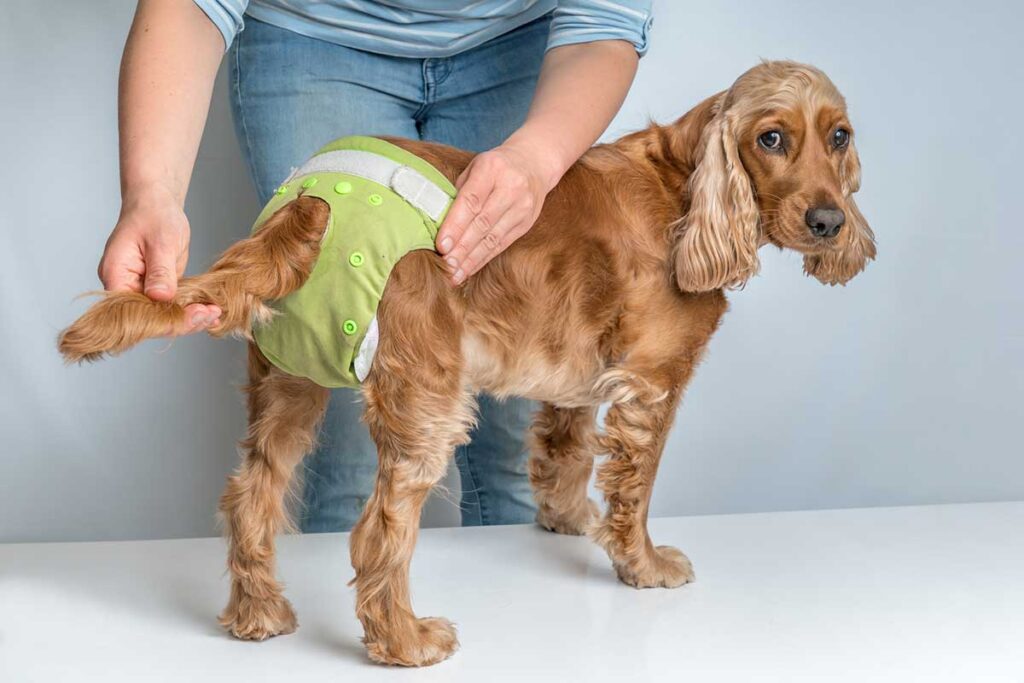
If your dog only loses control when they’re sleeping, you can just put a diaper on them before it’s time for bed or when they’re taking a nap. If it’s a more constant dribble, then they may need to wear them for longer periods. View our favorite doggie diapers.
2. Be Ready for Dog Urine Clean-Up: Having the right urine odor and stain removal products at hand can make life a lot easier. Keep plenty of absorbent paper towels or old bath/hand towels in strategic places around your house for instant mop-up. We have tried just about all of the most popular pet cleaning products: find the ones that have passed in-home testing in our list of favorite dog urine cleaning products.
3. Get a Waterproof Dog Bed: There are no totally waterproof beds, but our page about waterproof dog beds features those that are very good at repelling urine or have removable covers and waterproof liners.
4. Proof your House & Car with Waterproof Covers: If your old dog is regularly using your couch, bed, or car seats, consider waterproof sheets or rubber-backed sheets or blankets. View our recommended waterproof blankets. You can also buy a waterproof car seat cover for less than $40 on Amazon.
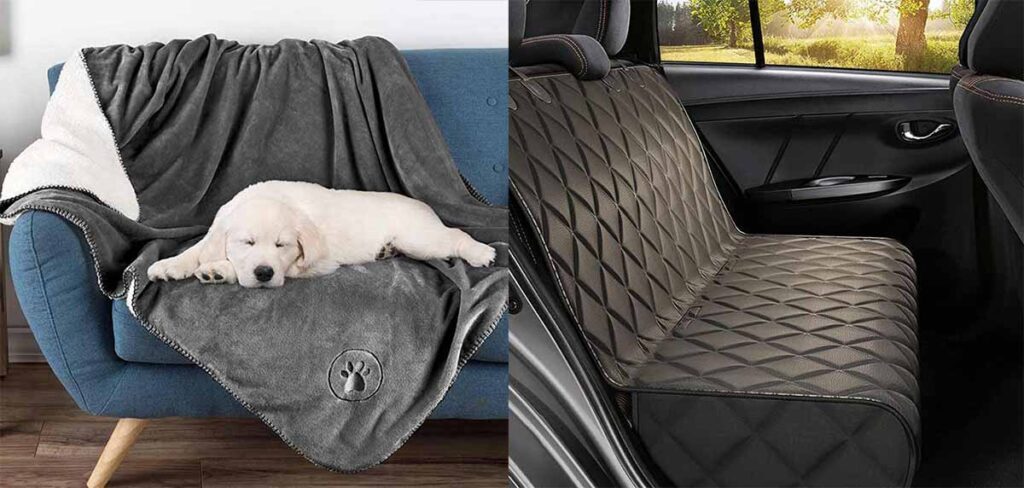
5. Place Doggy Potty Training Pads Strategically Around Your House: you can use disposable potty training pads (Amazon link) positioned under or next to your dog’s bed, or in strategic places around the house, to help make accidents easier to clean up. To help your old dog understand this new process, place a paper towel with a few drops of their urine over the new training pad.
6. Use Dog Urinary Health Supplements: natural supplements can help support healthy urinary tract function. They won’t stop incontinence, but they can help prevent it from getting worse as well as keep your dog’s bladder healthy.
In addition to vet-prescribed medications or procedures, a range of natural products are designed to help keep your dog’s urinary system healthy and functioning as well as it possibly can. There are many different options to choose from, including options from reputable, well-regulated manufacturers that we trust. View our recommendations for dog urinary health supplements or learn more about the best dog incontinence products.
How Do you Stop an Older Dog From Peeing Inside?
How you treat your old dog’s incontinence problems depends on what is causing the issue in the first place.
Depending on the cause, there are lots of effective remedies available for Fifi or Fido’s leaky plumbing issues, from medications and supplements, to surgery. Learn more about the best treatment options on our page about treatment options for old dog incontinence.
Questions Your Vet May Ask You
A senior dog peeing in the house is often a symptom of a more serious condition. If your old dog is regularly peeing indoors, we recommend that you take him to your local veterinarian. You will want to be prepared to help your veterinarian diagnose the cause of your dog’s incontinence.
Questions Your Vet May Ask you: your veterinarian will first ask you several questions about the nature of your dog’s urinary issue, such as:
- how long has your dog been incontinent? is your dog generally well?
- how often is your dog peeing throughout the day? is your dog peeing more frequently now?
- is your dog straining to urinate (or is urine dribbling out)?
- is your dog drinking and urinating more than usual?
Bring a Urine Sample with You
Your vet will thank you for bringing it. Ideally, collect the sample first thing in the morning as this will measure how well the kidneys are concentrating the urine. A urine sample can provide key insights into your dog’s health. By analyzing the urine for the presence of different components such as glucose, protein, blood cells, and bacteria, as well as testing the pH, your vet can get a really good idea of what might be causing the symptoms your dog is displaying.
Sometimes your vet may need to take a sterile urine sample directly from your dog’s bladder with a needle, especially if they are concerned about a urinary tract infection. While this sounds scary, most dogs tolerate it very well, and sedation can be given if not.
Physical examination: Your vet will also perform a physical examination, assessing various body systems and looking for clues as to what might be causing the incontinence. However, there is only so much information your vet can acquire from the examination, and often further tests will be required.
Additional tests: In some cases, additional tests, such as blood tests, can be performed to help diagnose the condition. Key parameters can give an insight into how well the kidneys are functioning, white blood cell levels can help identify the presence of infection, and hormone tests can help look for endocrine diseases that may be influencing the urinary system.
An ultrasound scan of your dog’s bladder and kidneys can identify possible structural changes that might be causing urinary symptoms such as incontinence. Your vet will look for abnormalities such as bladder stones or growths.
Vet Video: Causes of Incontinence and Questions Your Vet Might Ask You
Watch our veterinary advice video below to learn about the main causes of a dog peeing inside the house, and how you should prepare for the veterinary visit:
Collecting A Urine Sample Before Your Visit to the Vet
In most cases, your veterinarian will need to test a sample of your dog’s urine to find out what’s causing the ‘peeing’ problems.
Sometimes they will ask you to collect a sample and bring it in. This means you need to ‘catch’ the urine while Fido or Fifi is urinating – easier said than done!
IMPORTANT TIP: I recommend that your helper be the ‘catcher’ because if you do it, your dog is more likely to turn around and try to figure out what’s going on. That can make the whole procedure messy.
If you’re keeping his attention at the ‘head’ end, the ‘business’ end will be less likely to move!
The best way to do this is to ask someone else to help you because it’s very tricky to do it all by yourself.
With your dog on a leash, take them to their potty spot, and while you keep their attention, your ‘assistant’ needs to use a very CLEAN container to catch the urine, mid-stream if possible.
Remember, never use a jar that has had something sweet in it at one point, as residual sugars may lead to an incorrect diagnosis of diabetes.
You don’t need a whole jar of urine, most tests only need two or three milliliters. Once you do have your sample, make sure to refrigerate it until it’s time to get it to the vet’s office.
When an infection is suspected, your veterinarian will often want to take a sample of urine directly from your dog’s bladder (this is called a ‘cystocentesis’ sample).
This isn’t nearly as difficult as it sounds and is the most accurate way to find out exactly what type of bacteria or infection is causing the problems.
To Wrap It All Up…
Okay, so we’ve covered all the most common reasons for an older dog peeing in the house, and now you know what each group of symptoms could mean.
If there are signs of a physical problem, please get your dog examined by your veterinarian just as soon as you can. The quicker you get a diagnosis, the easier it will be to treat the problem.
Related Post about Senior Dog Peeing & Incontinence:
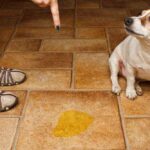 What to Do if Your Old Dog Suddenly Started Peeing Inside Because of Emotional Reasons - We have reviewed in depth the reason causing old dogs to suddenly start peeing inside the house. Most of the… [...]
What to Do if Your Old Dog Suddenly Started Peeing Inside Because of Emotional Reasons - We have reviewed in depth the reason causing old dogs to suddenly start peeing inside the house. Most of the… [...] Old Dog Incontinence - Old dog incontinence is more common in spayed females, but leaky plumbing can affect dogs of both sexes. It also… [...]
Old Dog Incontinence - Old dog incontinence is more common in spayed females, but leaky plumbing can affect dogs of both sexes. It also… [...] Best Dog Incontinence Products - Dog incontinence products are designed to make life with a leaky-dog easier for everyone. It doesn't matter whether your dogs'… [...]
Best Dog Incontinence Products - Dog incontinence products are designed to make life with a leaky-dog easier for everyone. It doesn't matter whether your dogs'… [...]Read this article if your old dog is urinating frequently or large amounts.
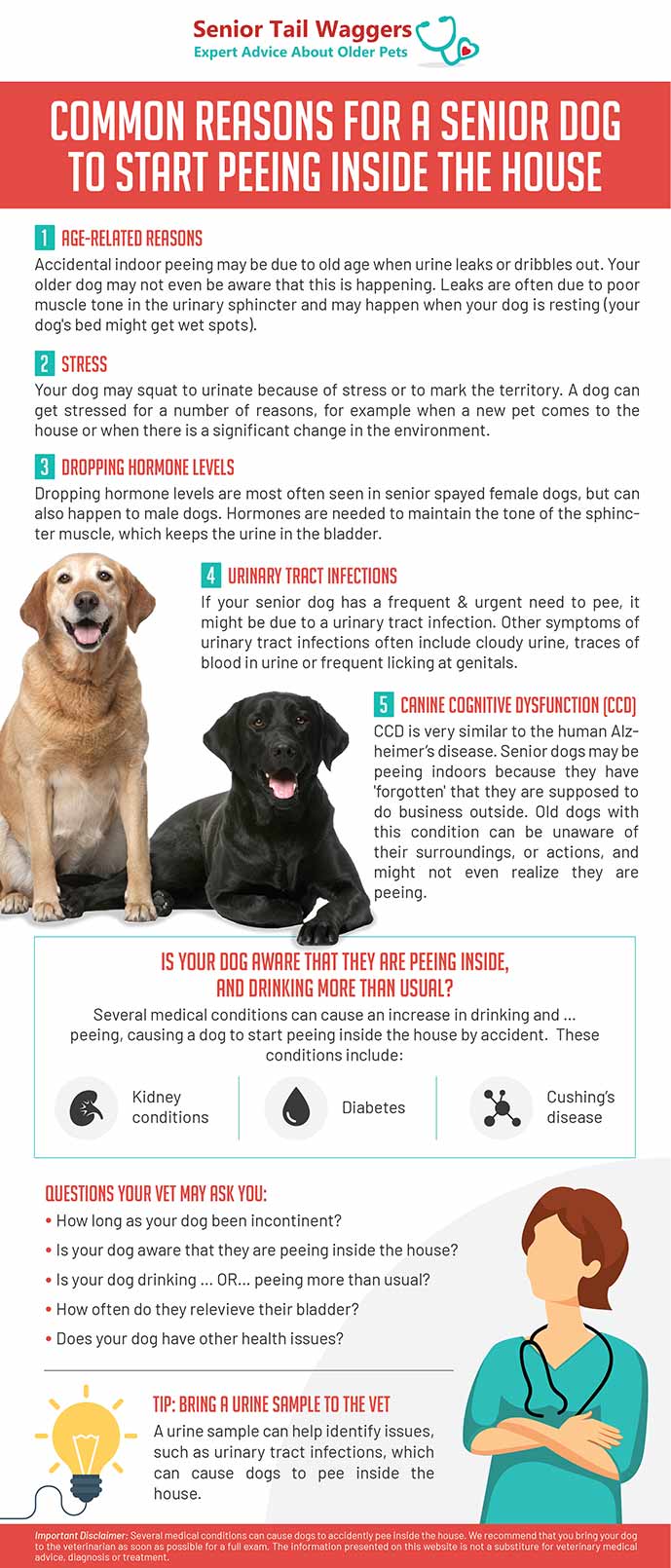
Disclaimer: This website's content is not a substitute for veterinary care. Always consult with your veterinarian for healthcare decisions. Read More.




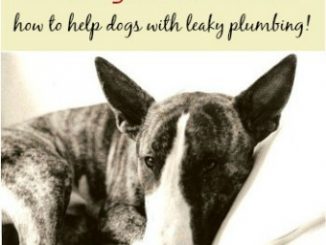

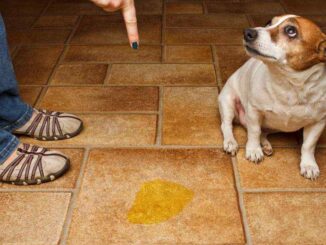
I have an 8year old cairn terrier called bonnie she has always slept in my room but now is peeing in my room constantly despite being let out she knows she is doing wrong any advise whyherbehaviour is like this
My 7.5 female cairn terrier has been peeing in the bedroom every night lately. We take her out every 3-4 hours and that’s never changed. She’s afraid of storms so I’m not surprised when she does pee inside due to that, but this new, nightly peeing is a conundrum. It’s usually the same spot, in the middle of the night. I don’t know what has changed to cause a behavioral change in her. For the past few year she’s been waking up in the middle of the night and will start barking very loudly and shrilly and will not stop most of the time until she goes out. I don’t know what to do with her. My husband doesn’t think it’s a physical cause, she’s just behaving like this on purpose.
I have a 14 and half year old springer spaniel she has always been very good with holding off having a wee she can go all day without having one but all of a sudden she has started having a little one when she is a sleep
My 13 year old is peeing the bed and he Sri ks his water and it just comes out every ones is saying it time to put him to sleep is this trie
I have a staff and she is house trained but at the mom she is in season and she’s not eating but drinking loads she’s sleeping loads and she’s starting peeing in the house she’s also having trouble getting up and down the stairs what can I do
My 5 year old Lhasa Apso is peeing/marking my beds and continually peeing in the kitchen (even though I put pee mats in the kitchen) He is sometimes left alone from 9am-6pm due to work commitments but never pees during this time. He is let out often but is still doing it. Help !!
My 13 year old daschund is doing the same thing. Has anyone responded with an answer yet?
I have a 15 yr old and for the last 2 months he stays out for 30 min (except when extremely cold) still comes in and pees! No medical issues either but he seems disoriented and is having vision issues (age related)
Really, are you kidding me? The article has your answers. I can understand sharing experiences but there is no way the person who wrote the article can know YOUR DOG. Take your dogs to the vet, they are the only ones that can run necessary tests and diagnose. Wow.
Thank you, Anonymous. That was soooo helpful. I believe the purpose of this community is to support each other as we worry about our dogs. Of course they will be seen by a vet. Of course we’ll eventuslly figure it out, but we look to each other to share experiences, not to be berated by you. Please don’t bother coming here if it irks you so much to be part of a community.
Ha “Wow.” why are you here if you’re so annoyed? The POTUS spreads enough negativity for the whole country, we don’t need you spreading more – on a DOG thread haaaa
Well said
What’s a POTUS?? Is that a type of Vetrinarian or Doggy Specialist??
I agree w\ “Wow”. You can’t have a random person tell you what’s wrong w/ your dog based off a low description comment of your dogs peeing habits off of a website. The site says it all, look at your damn situation and go to your vet. Its not rocket science. My 12 yr old Boxer Rot mix has peed 2 times this week, in the living room in the exact same spot. Being trained since birth and only having accidents on vacations, random long events, etc.
I totally agree with the dogs owner. She is asking very important issues.
This makes no sense: “Two very common symptoms of diabetes in dogs are increased thirst, and increased urination… So, if your older dog is peeing in the house and also seems to be extra-thirsty, this is something you need to rule out.”
I have a 12-year old miniature Schnauzer and he recently has started peeing in the house. He had a complete checkup in March and everything looked good. His “alpha” (my Dad) passed away in November and I’m beginning to think this recent bout of peeing everywhere in the house is seperation anxiety. He really has been disobedient since this happened. Will he grow out of this phase or is this something that might need to be medicated?
I had problems with dog peeing in the house too. My 9 years old dog started to pee on the floor, plus, he had problems with walking. So i decided to buy indoor dog potty and it worked for us.
Wow so you managed to bring in pot and the President, this is not the forum for either🤦🏻♀️